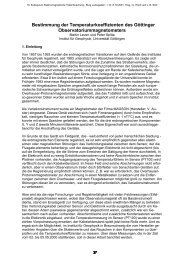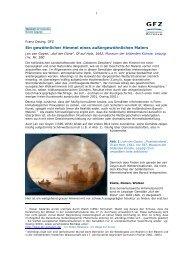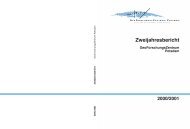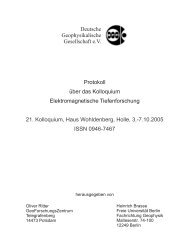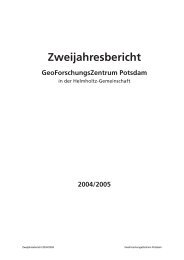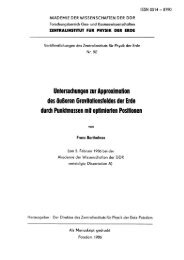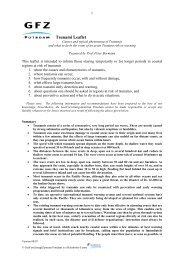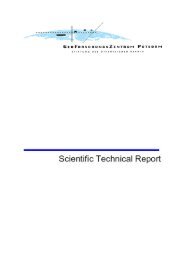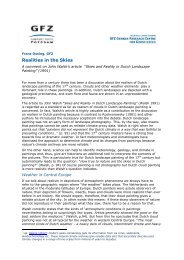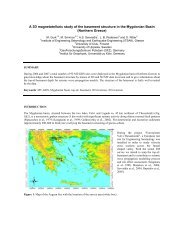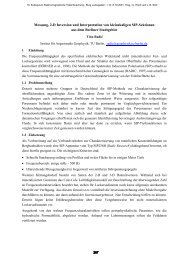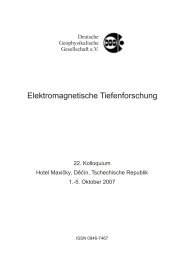Cave detection using the Self-Potential-Surface (SPS) technique on ...
Cave detection using the Self-Potential-Surface (SPS) technique on ...
Cave detection using the Self-Potential-Surface (SPS) technique on ...
Create successful ePaper yourself
Turn your PDF publications into a flip-book with our unique Google optimized e-Paper software.
19. Kolloquium Elektromagnetische Tiefenforschung, Burg Ludwigstein, 1.10.-5.10.2001, Hrsg.: A. Hördt und J. B. Stoll<br />
3 <str<strong>on</strong>g>SPS</str<strong>on</strong>g> method<br />
Figure 3a represents <str<strong>on</strong>g>the</str<strong>on</strong>g> <str<strong>on</strong>g>SPS</str<strong>on</strong>g> model for a subhoriz<strong>on</strong>tal layered structure in karst. According to Aubert<br />
et al. (1990) and Aubert & Atangana (1996), three specific c<strong>on</strong>diti<strong>on</strong>s shall be satisfied in this model:<br />
1) A high ratio between <str<strong>on</strong>g>the</str<strong>on</strong>g> resistivity of <str<strong>on</strong>g>the</str<strong>on</strong>g> unsaturated z<strong>on</strong>e (A) and <str<strong>on</strong>g>the</str<strong>on</strong>g> resistivity of <str<strong>on</strong>g>the</str<strong>on</strong>g><br />
impermeable z<strong>on</strong>e (B)<br />
2) Z<strong>on</strong>e (A) is composed out of porous and homogenous medium<br />
3) The resistivity distributi<strong>on</strong> of z<strong>on</strong>e (A) is homogenous<br />
The interface (C) is <str<strong>on</strong>g>the</str<strong>on</strong>g> c<strong>on</strong>tact between z<strong>on</strong>e (A) and z<strong>on</strong>e (B). Under <str<strong>on</strong>g>the</str<strong>on</strong>g> above menti<strong>on</strong>ed c<strong>on</strong>diti<strong>on</strong>s,<br />
Aubert et al. (1990) and Aubert & Atangana (1996) give <str<strong>on</strong>g>the</str<strong>on</strong>g> following experimental linear relati<strong>on</strong>:<br />
V(<br />
x,<br />
y)<br />
d(<br />
x y)<br />
= + d°<br />
K<br />
, (1)<br />
d ( x,<br />
y)<br />
is <str<strong>on</strong>g>the</str<strong>on</strong>g> thickness of <str<strong>on</strong>g>the</str<strong>on</strong>g> unsaturated z<strong>on</strong>e (A) and V( x,<br />
y)<br />
is <str<strong>on</strong>g>the</str<strong>on</strong>g> range of SP anomaly measured at<br />
<str<strong>on</strong>g>the</str<strong>on</strong>g> surface.<br />
K is a coefficient in Volt/Meter, E° is <str<strong>on</strong>g>the</str<strong>on</strong>g> known thickness of z<strong>on</strong>e (A) below <str<strong>on</strong>g>the</str<strong>on</strong>g> SP reference point<br />
R, where V ( R)<br />
= 0 Volt by c<strong>on</strong>venti<strong>on</strong>.<br />
The interface (C) would <str<strong>on</strong>g>the</str<strong>on</strong>g>n be an equipotential surface, called <str<strong>on</strong>g>the</str<strong>on</strong>g> <str<strong>on</strong>g>Self</str<strong>on</strong>g>-<str<strong>on</strong>g>Potential</str<strong>on</strong>g>-<str<strong>on</strong>g>Surface</str<strong>on</strong>g> (<str<strong>on</strong>g>SPS</str<strong>on</strong>g>).<br />
K is a functi<strong>on</strong> of various parameters including <str<strong>on</strong>g>the</str<strong>on</strong>g> average resistivity of z<strong>on</strong>e (A) and <str<strong>on</strong>g>the</str<strong>on</strong>g> resistivity of<br />
z<strong>on</strong>e (B). When <str<strong>on</strong>g>the</str<strong>on</strong>g> <str<strong>on</strong>g>SPS</str<strong>on</strong>g> is sub-horiz<strong>on</strong>tal, K defines <str<strong>on</strong>g>the</str<strong>on</strong>g> topographic effect in SP and we can derive<br />
K by:<br />
dV<br />
K = , (2)<br />
dh<br />
i.e. by <str<strong>on</strong>g>the</str<strong>on</strong>g> vertical SP gradient from <str<strong>on</strong>g>the</str<strong>on</strong>g> reference point R down to <str<strong>on</strong>g>the</str<strong>on</strong>g> surface of z<strong>on</strong>e (B):<br />
dV(<br />
R )<br />
K = , (3)<br />
d°<br />
K can be determined from borehole informati<strong>on</strong> or laboratory measurements of rock samples of z<strong>on</strong>e<br />
(A).<br />
If <str<strong>on</strong>g>the</str<strong>on</strong>g> field topography ( x y)<br />
topography of <str<strong>on</strong>g>the</str<strong>on</strong>g> <str<strong>on</strong>g>SPS</str<strong>on</strong>g>:<br />
h , and <str<strong>on</strong>g>the</str<strong>on</strong>g> SP mapping ( x,<br />
y)<br />
V are known, we can <str<strong>on</strong>g>the</str<strong>on</strong>g>n calculate <str<strong>on</strong>g>the</str<strong>on</strong>g><br />
V(<br />
x,<br />
y)<br />
H(<br />
x,<br />
y)<br />
= h(<br />
x,<br />
y)<br />
− d°<br />
−<br />
(4)<br />
K<br />
The <str<strong>on</strong>g>SPS</str<strong>on</strong>g> topography will give <str<strong>on</strong>g>the</str<strong>on</strong>g> topography of <str<strong>on</strong>g>the</str<strong>on</strong>g> impermeable z<strong>on</strong>e (B).<br />
A cave will significantly change <str<strong>on</strong>g>the</str<strong>on</strong>g> potential distributi<strong>on</strong> in <str<strong>on</strong>g>the</str<strong>on</strong>g> structure and <str<strong>on</strong>g>the</str<strong>on</strong>g>refore <str<strong>on</strong>g>the</str<strong>on</strong>g> SP mapping<br />
at surface. In our working model for <str<strong>on</strong>g>the</str<strong>on</strong>g> field experiment (Fig. 3b), a possible equipotential surface is<br />
thought to align with <str<strong>on</strong>g>the</str<strong>on</strong>g> bottom of <str<strong>on</strong>g>the</str<strong>on</strong>g> cave. Ano<str<strong>on</strong>g>the</str<strong>on</strong>g>r possible equipotential surface can be c<strong>on</strong>sidered<br />
to follow <str<strong>on</strong>g>the</str<strong>on</strong>g> roof of <str<strong>on</strong>g>the</str<strong>on</strong>g> cave.



